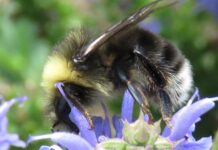
To raise awareness of the importance of pollinators, the threats they face, and their contribution to sustainable development, the United Nations (UN) designated May 20 as World Bee Day in 2017. With the theme “Bee engaged in pollinator-friendly agricultural production,” World Bee Day 2023 calls for global action to support pollinator-friendly agricultural production and highlights the importance of protecting bees and other pollinators.
According to the UN, present bee species extinction rates are 100 to 1,000 times higher than normal due to human impacts. Close to 35% of invertebrate pollinators, particularly bees and butterflies, and about 17% of vertebrate pollinators, such as bats, face extinction globally.
Yet pollination is a fundamental process for the survival of our ecosystems. Nearly 90% of the world’s wild flowering plant species depend, entirely, or at least in part, on animal pollination, along with more than 75% of the world’s food crops, and 35% of global agricultural land. If this trend continues, crops such as fruits, nuts, and many vegetables will be substituted increasingly by staple crops like rice, corn, and potatoes. Not only do pollinators contribute directly to food security, but they are key to conserving biodiversity.
 New Bee Book: 10 Facts
New Bee Book: 10 Facts
To help inspire empathy for bees, here’s more about them. In the recently published, What a Bee Knows: Exploring the Thoughts, Memories, and Personalities of Bees, pollination ecologist Stephen Buchmann brings readers into the mysterious, fascinating minds of bees and introduces the scientists and researchers uncovering their alien ways of seeing the world. Here are some surprising facts about the inner world of bees from Buchmann:
- Although bee brains are incredibly small—just one million neurons compared to humans’ 100 billion—they have remarkable abilities to navigate, learn, solve problems, communicate, and remember.
- Global bee diversity is about the same as the number of fish species. There are 21,000 species in the world, with roughly 3,500 species from the continental US alone.
- Most bees in the world are actually ground-nesting and solitary, with no queen or workers. Only about 10% of the world’s bees are social, including honeybees and bumblebees.
- Bees are sentient, self-aware, can likely feel pain, and may have a simple form of consciousness.
- Despite being the size of a poppy seed, a honeybee’s brain is quite complex. It has almost one million neurons and up to a billion synaptic connections.
- Bee eyes detect ultraviolet light. They can see hidden UV nectar guide patterns that are invisible to humans.

- Bees have been trained how to use a string as a tool, pulling the string to access a sugar reward under a clear plastic cover.
- Far more than mindless drones, bees may actually play. In a laboratory, bumblebees rolled small wooden balls around without rewards.
- Bees can not only count to four, but they can also remember the shapes, scents, and colors of flowers for up to three days.
- 130 million years ago, bees evolved from carnivorous wasps during the early Cretaceous period. These first ones were tiny, just a few millimeters long, matching the size of the earliest flower.
Read the original article in the National Garden Bureau online newsletter.
For more on supporting pollinators, see The Science Against No Mow May.











![[VIDEO] Dickies®: Discover Workwear That’s Anything But Uniform](https://turfmagazine.com/wp-content/uploads/2023/06/1647663814-4b1a2a7742790a9b1e97a3b963477850192e1d6a9dfba9b07214a77bae25d6e3-d-218x150.jpg)



























 New Bee Book: 10 Facts
New Bee Book: 10 Facts



![[VIDEO] Dickies®: Discover Workwear That’s Anything But Uniform](https://turfmagazine.com/wp-content/uploads/2023/06/1647663814-4b1a2a7742790a9b1e97a3b963477850192e1d6a9dfba9b07214a77bae25d6e3-d-324x160.jpg)